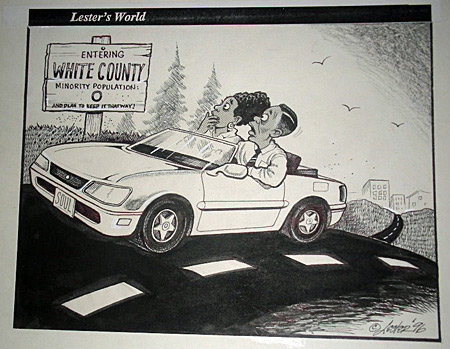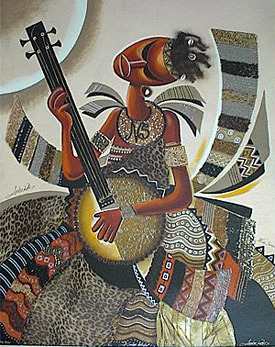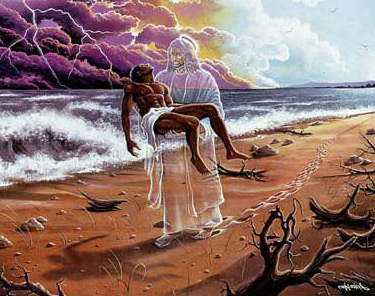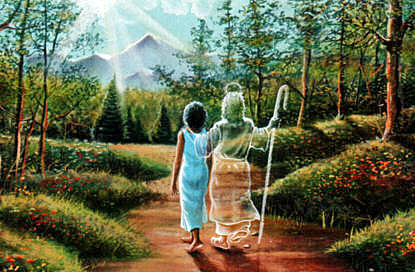Friday at Auction Finds is readers’ questions day. I try to guide readers to resources for them to determine the value of their items. I’m not able to appraise their treasures, but I can do some preliminary research to get them started. So, these are market values based on prices I find on the web, not appraisal for insurance purposes that I suggest for items that have been determined to be of great value.
Today’s question is from a reader who came across some drawings by African American cartoonist and artist Lester Kern.

Question:
A few weeks ago I ran across 30 original drawings by Lester Kern who passed away a few years ago. The comic drawings are from his comic strip entitled “Lester’s World.” The dates range from the mid-80’s to the early 90’s. I have been trying to find a website or auction house that might know something about them. He grew up in Milwaukee. I checked with a few places but they had never heard of him. You can Google him and see how prolific he was. If you can help in any way, please let me know.
Answer:
The reader wrote to me after reading my blog post about a print I had found at auction recently by African American artist Alvin C. Hollingsworth, who was also a comics book illustrator.
I had never heard of Kern, and I’m always looking to be introduced to new artists. The reader wrote in a subsequent email that he got the cartoons from a friend who buys storage units at auction. “These came along with some other ‘stuff’ that I bought,” he said.

His discovery of those cartoons reminded me of the time when I stumbled upon at auction about 25 loose pages of comic drawings by Bo Brown, whose works appeared in the Saturday Evening Post, the New Yorker and hundreds of other publications. He created a comic strip called “Such is Life” in 1936 and another featuring Professor Quagmire that ran in the University of Pennsylvania alumni magazine from 1946-1971.
I found some biographical information about Kern, but I had to dig deep into Google to find out more about his cartoons.
Lester J. Kern was first and foremost a painter, who grew up and lived most of his life in Milwaukee, WI. He became interested in art as a very young child, and he and his younger brother got scholarships for classes at the Milwaukee Art Museum when Kern was 10. He was first published at the age of 13, and was working part time as a staff cartoonist by the age of 16. He later won a full scholarship to the University of Wisconsin-Superior, but left because he was eager to create art.

In a YouTube video from 2008, Kern said that his grandfather wanted him to become a boxer like his two uncles and the grandfather’s nephew Archie Moore.
“He was going to find himself another champion in the family if it killed him,” Kern said. So Kern trained and fought, but realized that he wasn’t very good in the ring. So he told his grandfather that he wanted to be an artist.
“So, he changed. He got rid of the boxing gloves and the punching bags and the sand bags and the rings in the basement and I came home one day and I had easels and paints and everything else and I’ve been doing it ever since,” he said in the video produced by Ethnic Expressions.
When selling his art got slow, Kern took up driving an 18-wheeler to pay the bills. Along his routes, he took photos with his digital camera and painted what he had captured after he got back home.

He began his career as an editorial cartoonist at the Milwaukee Courier in the 1970s and later at the Milwaukee Community Journal. When Kern died in 2010, a former colleague wrote a warm tribute in honor of him.
“They knew him as a visionary of inimitable talent, an artist whose creative images and contemporary themes placed him among the top artisans of our era,” wrote Mikel Holt, associate publisher of the Community Journal who worked with Kern in the early years of the newspaper. “I knew him as a satirist, an Africentered pundit whose sword was a cartoonist’s pen that brought to life the pride and anguish, the impotence and strength of Black America. … As a cartoonist, he had no equal.”
Kern’s syndicated cartoon “Lester’s World” ran in 50 newspapers across the country, including the Miami Times and Toledo Journal. “The cartoon dealt with issues of racism. It dealt with politics, drugs, violence, education, family values,” he said in the video – some of the same things that were going on in his own home. Seeing himself a hypocrite, he soon strayed away from drawing the cartoon.

Kern won three first-place awards from the National Newspaper Publishers Association as the Best Editorial Cartoonist.
He eventually moved to the Atlanta area to focus more on his artwork, producing a prolific flow of paintings. His religious work “Footprints” seemed to have wowed a lot of people, but he didn’t make a lot of money from it, he said in the video. It was reproduced by others without his permission, he said.

I found tons of reproduction prints and posters of Kern’s artwork on the web, but I found none of his original paintings. He seemed to have painted abstracts, landscapes and African American people. His medium of choice appeared to have been watercolor.
Kern died of prostate cancer in 2010.
After what I found out about Kern’s cartoons, the reader is fortunate to have some of his original drawings. But inquiring about such a specialized field at a local auction house would be a hit-and-miss endeavor. When I tried searching for Bo Brown those years ago, I got lucky and found some of his works that had been sold.
Unlike Kern, Brown worked for mainstream publications and his works were more visible in the world of cartooning. Kern’s cartoons ran in black publications and could easily be missed or lost to history.

I checked the website of the Billy Ireland Cartoon Library and Museum at Ohio State University to see if his name would show up. My search turned up a biographical file on Kern but I could not access the file. I’d have to go to the library itself to do that. I checked a few other cartoon sites but could find no entries.
Another avenue for the reader is to contact an auction house like Swann Auction Galleries in New York, which each years conducts a sale of African American manuscripts and ephemera. The auction house has sold works of Black Panther illustrator and artist Emory Douglas, although he wasn’t a cartoonist and was associated with an historical organization.
A person knowledgeable about the cartoon industry may be able to offer an opinion about Kern’s works based on their place in the history of the craft. There were not many African American cartoonists, and as a result, I would assume that their works are historically valuable. It may require a little more digging on the reader’s part.

Lester’s World were political cartoons that were published in several black newspapers years ago. I was Lester’s wife during that time and we opened a graphic design studio here in Milwaukee, Wisconsin. Lester was a very talented artist and I wished our son was able retrieve his work as a way to remember his dad and know other aspects of his father’s work and his legacy.